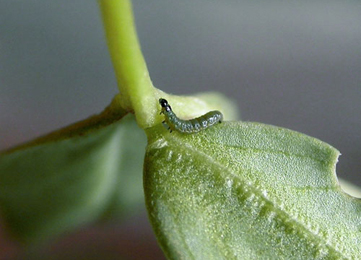|
||||||
|
MEDICAGO. Medicks. [Fabaceae] |
|
|
Thirty species of Medicago are recorded in Britain. These include the native Spotted Medick (M. arabica), Black Medick (M. lupulina), Bur Medick (M. minima), Toothed Medick (M. polymorpha), Sand Lucerne (M. sativa varia) and Sickle Medick (M. sativa falcata). The BSBI provide a downloadable plant crib for Medicago and the varieties of Medicago lupulina. Medicago sativa subsp. varia is treated as Medicago sativa nothossp. varia by Stace (2010). Seventeen British miners recorded on Medicago. The non-British polyphagous miners Liriomyza huidobrensis and Liriomyza trifolii have been found under glass in England and Wales. All populations have been and continue to be eradicated. See also Liriomyza species in Glasshouses and/or Quarantine Interceptions. A key to the European miners recorded on Medicago is provided in Bladmineerders van Europa. |
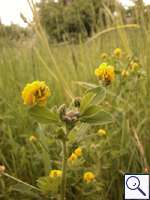 Black Medick Medicago lupulina |
Key for the identification of the known mines of British |
Note: Diptera larvae may live in a corridor mine, a corridor-blotch mine, or a blotch mine, but never in a case, a rolled or folded leaf, a tentiform mine or sandwiched between two more or less circular leaf sections in later instars. Pupation never in a cocoon. All mining Diptera larvae are leg-less maggots without a head capsule (see examples). They never have thoracic or abdominal legs. They do not have chewing mouthparts, although they do have a characteristic cephalo-pharyngeal skeleton (see examples), usually visible internally through the body wall. The larvae lie on their sides within the mine and use their pick-like mouthparts to feed on plant tissue. In some corridor miners frass may lie in two rows on alternate sides of the mine. In order to vacate the mine the fully grown larva cuts an exit slit, which is usually semi-circular (see Liriomyza huidobrensis video). The pupa is formed within the hardened last larval skin or puparium and as a result sheaths enclosing head appendages, wings and legs are not visible externally (see examples). See Key to non-Diptera. |
1a > Stem-miner: A narrow, inconspicuous stem mine. Pupation at the end of the mine (Spencer, 1976: 64). Fine, upper- or lower-surface corridor, ending in a thick vein. From there the mine extends finally to the rind of the stem. There also the pupation takes place, usually not far from the root collar. Mines in the stem rind often are conspicuous through a red discoloration. |
|
Ophiomyia curvipalpis (Zetterstedt, 1848) [Diptera: Agromyzidae]. |
1b > Leaf-miner |
2a > Leaf-miner: A distinctive mine primarily above mid-rib, with irregular short lateral offshoots into leaf blade. Pupation external (Spencer, 1972: 51 (fig. 172), 55; Spencer, 1976: 270, 271 (fig. 486)). Branched, whitish, upper-surface corridor; main axis overlying the midrib; side branches overlying the main lateral veins. (In Campanula and Phyteuma the mine is much less branched, sometimes nothing more than a corridor on top of the midrib). Frass in rather long strings. Usually the mines begins as a long and narrow, shallow, tortuous lower-surface corridor that ends upon the midrib but otherwise is not associated with the leaf venation. Often this initial corridor is filled with callus, and then even less conspicuous. Pupation outside the mine. A linear mine on the upper surface, usually following the midrib and showing side branches along the veins. The frass is in strings. |
|
Liriomyza strigata (Meigen, 1830) [Diptera: Agromyzidae]. |
2b > Leaf-miner: Initially a linear mine running towards apex of leaf which then turns back and develops into a blotch in the area of the mid-rib (Spencer, 1972b: 37, fig. 114A; Spencer, 1976: 110, fig. 177). Upper-surface corridor along the leaf margin, running from the leaf base to the tip. Once at the tip the corridor goes down over the midrib, widening considerably. Frass in the corridor part in a broad green central band, with minute black particles at either side. In the final, blotchy part frass in coarse black grains that may sometimes stick together. Pupation outside the mine. Puparium reddish brown. |
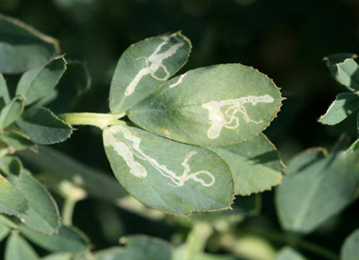 Mines of Agromyza frontella on Medicago sativa Image: © Whitney Cranshaw (Bladmineerders van Europa) |
|
Agromyza frontella (Rondani, 1875) [Diptera: Agromyzidae]. |
2c > Leaf-miner: Larva producing a short narrow linear mine not associated with the margin, which then develops into a conspicuous white blotch centred on the mid-rib. At the end of feeding the larva lies for one or two days along the mid-rib. Pupation external (Spencer, 1972b: 37 (fig. 114b); Spencer, 1976: 126, fig. 213A). Broad and short hook-like upper-surface corridor, ending in a little blotch in the centre of a leaflet. The blotch is upper-surface as well, but has some deep spots, giving the mine a mottled appearance when hold against the light. Frass in the blotch in a few large lumps. Pupation outside the mine. A short, broad gallery leading to a conspicuous, roundish white blotch in the centre of the leaf. The blotch is upper surface with full depth spots - comprising of large clumps of frass. Puparium reddish |
|
Agromyza nana Meigen, 1830 [Diptera: Agromyzidae]. |
2d > Leaf-miner: Mine linear, whitish, both upper and lower surface. Pupation internal, at the end of the mine with the anterior spiracles projecting through the epidermis (Spencer, 1976: 433). Upper-surface, less often lower-surface corridor. Frass in isolated grains. Pupation within the mine, usually in a lower-surface puparial chamber. A long whitish upper surface corridor, which eventually goes lower surface. |
|
Chromatomyia horticola (Goureau, 1851) [Diptera: Agromyzidae]. |
2e > Leaf-miner: An upper surface linear mine with frass in conspicuous greenish strips, largely alternating at each side of the channel. Puparium yellow |
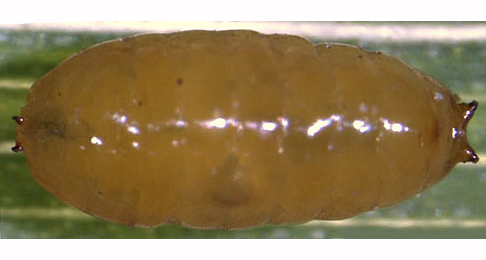 Liriomyza congesta puparium Image: © Willem Ellis (Bladmineerders van Europa) |
|
Liriomyza congesta (Becker, 1903) [Diptera: Agromyzidae]. |
2f > Leaf-miner: An upper or lower surface shallow winding linear mine, which may develop into a secondary blotch. Pupation external (Spencer, 1976: 240). Puparium orange Upper- or lower-surface, greenish or whitish corridor, sometimes a blotch. The corridor does not widen much and is not associated with the midrib. Frass in conspicuous thread fragments, alternating along the sides of the corridor. Pupation outside the mine. The mine is also illustrated in British Leafminers. |
|
Liriomyza cicerina (Rondani, 1975) [Diptera: Agromyzidae]. |
2g > Leaf-miner: The mine starts as a long, narrow, winding corridor running towards the midrib, widening to a blotch. Usually upper-surface, but in small leaves also full-depth parts may occur. The blotch has broad lobes; in their ends most frass is accumulated in the form of green patches or clouds. Sometimes several larvae share mine. Pupation usually in the soil, less often in the leaf (and then generally not in the mine itself but in a small separated mine, that may even be made in the petiole). |
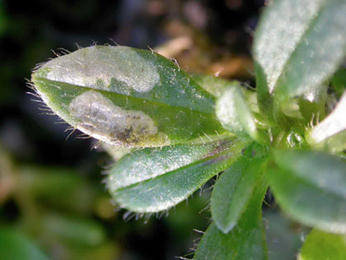 Mine of Scaptomyza graminum on Cerastium glomeratum Image: © Jean-Yves Baugnée (Bladmineerders van Europa) |
|
Scaptomyza graminum (Fallén, 1823) [Diptera: Drosophilidae]. |
2h> Leaf-miner: Corridor-blotch mine, normally dorsal; usually whitish; in small leaves it lies characteristically in the centre of the leaf often touching the petiole; in larger leaves it lies to one side of the mid-rib. Frass deposited in green clumps near the leaf margin. Pupation usually external, sometimes in a separate pupation mine. Oviposition whitin the leaf, at the lower surface. The first part of the mine is a long, sometimes very long, corridor, that mostly will be overrun by the later developments. Generally this corridor is directed, frequently guided by a thick vein, to the midrib. The next section of the mine is large, irregular blotch overlying the basal section of the midrib. Locally large chunks of midrib tissue are consumed. From this central blotch excursions are made into the leaf blade: generally upper-surface, less often lower-surface and locally full-depth. In plants with narrow leaves, like Diplotaxis, the mine may occupy the entire width of the leaf. Often several larvae together in a mine. Frass blackish green, powdery, in clouds, sometimes along the sides of the corridors, later more in the periphery of the mine and in the end of extensions of the blotch, sometimes seemingly absent. (Often the frass can only be seen after the mine has been opened). Pupation generally in the ground, rarely within he leaf, in a short mine without frass. Hendel (1928a) described the biology, larva and puparium. An initial narrow gallery then leads to a blotch on the midrib of the leaf. Watch a video of a scaptomyzid fly larva on Arabidopsis on YouTube by mash92587. |
|
Scaptomyza flava (Fallén, 1823) [Diptera: Drosophilidae]. |
2i > Leaf-miner: A short, irregular, linear upper surface mine on any part of the leaf. Also recorded from young pods (Bland, 1997a). Long corridor mine. As a rule the first part of the mine is lower-surface, the later part upper-surface. Often the loops are so dense that a secondary blotch is the result. Because upper- and lower-surface corridor segments often cross, the mine obtains a strange array of transparant patches. There is no association with the midrib. Frass in strings and thread fragments. Pupation outside the mine; exit slit in upper epidermis. Mine not associated with the veins or midrib of the leaf (It is this character which enables distinction from another Agromyzid pest species - Liriomyza huidobriensis). The larvae may leave one leaf (if not large enough) and enter another leaf, via the petiole). It exits the leaf to pupate through a semi-circular slit in the upper surface of the leaf. |
|
Liriomyza bryoniae (Kaltenbach, 1858) [Diptera: Agromyzidae]. |
|
Key for the identification of the known mines of British |
|||
Note: The larvae of mining Coleoptera, Hymenoptera and Lepidoptera may live in a corridor mine, a corridor-blotch mine, a blotch mine, a case, a rolled or folded leaf, a tentiform mine or sandwiched between two more or less circular leaf sections in later instars. Larva may pupate in a silk cocoon. The larva may have six legs (although they may be reduced or absent), a head capsule and chewing mouthparts with opposable mandibles (see video of a gracillarid larva feeding). Larvae of Hymenoptera and Lepidoptera usually also have abdominal legs (see examples). Frass, if present, never in two rows. Unless feeding externally from within a case the larva usually vacates the mine by chewing an exit hole. Pupa with visible head appendages, wings and legs which lie in sheaths (see examples). |
|||
1a > Leaf-miner and case-bearer: The larva lives outside the mine, protected by a case, and feeds on the underlying plant tissues via a hole cut in the epidermis. From that point it eats away as much leaf tissue as it can reach without fully entering the mine. Mine does not contain frass (Coleophora species) |
|||
1b > Leaf-miner, but not a case-bearer: The larva lives mainly inside the mine. Mine usually contains frass. In later instars the larva may live sandwiched between two more or less circular sections cut from the leaf. |
|||
2 > Leaf-miner and case-bearer: The initial mine is like that of a nepticulid. The case is made form excised leaf portions, which are added to the oral end, leading to the ringed appearance. The larva causes the leaf to have white blotches. Identification cannot be made on these alone as similar blotches can be made by early instar larvae of the Common Blue butterfly (Polyommatus icarus). Oviposition at the leaf underside, mostly in a vein axil. The larva begins by making a narrow winding corridor with much frass in a broad central line. The corridor reminds that of a nepticulid (but the egg has a finely reticulate surface, unlike the smooth nepticulid egg.) In the end the corridor widens into an oval blotch, usually close to the leaf margin, out of which the first case is made. The full grown larva in a greyish brown composite leaf case of about 6 mm, attached to the underside of a leaf. The oldest quarter of the case is bivalved, laterally compressed, and is at an angle of 70° with the anterior part of the case. The mouth angle is around 40°. |
|||
|
|||
? Coleophora discordella Zeller, 1849. |
|||
3a > Leaf-miner and leaf-spinner: The larvae feed between spun leaves and often mine them. The mine is illustrated in British leafminers. |
|||
|
|||
Syncopacma vinella (Bankes, 1898) [Lepidoptera: Gelechiidae]. |
|||
3b > Leaf-miner: The first generation initially forms an unmistakable leaf-mine on Anthyllis vulneraria, but the second generation feeds on the flowers. Feeding signs on other plants vary in appearance. Larvae can move between sewn leaves, and more than one larva may be found together. Larvae in a small full depth blotch, often with extensions. Frass concentrated in one corner of the mine. The mining activities may cause the leaf to roll inwards. Older larvae live free among spun leaves, but still they may make then full depth mines by feeding on the leaf tissue from a small opening. |
|||
|
|||
|
|||
Aproaerema anthyllidella (Hübner, 1813) [Lepidoptera: Gelechiidae]. |
|||
3c > Leaf-miner: In the first instar the larva mines the leaves, forming short, irregular, blotch-like mines, but in later instars it lives externally, feeding in spun leaves and often twisting those of tender shoots. Larval head light-brown or yellowish brown, edged with black postero-laterally, ocellar area blackish; prothoracic plate black edged with whitish anteriorly; abdomen dull dark green; pinacula distinct, black, sometimes brownish but with black bases to setae; anal plate large, black (Bradley et al., 1973). Small, full depth mine without a definite shape; little frass. Some silk is deposited in the mine. The larva soon leaves the mine and continues feeding among spun leaves.
|
|||
Cnephasia incertana (Treitschke, 1835) [Lepidoptera: Tortricidae]. |
|||
3d> Leaf-miner: Lower surface tentiform mine that occupies only part of a leaflet. In full grown leaves the mine is strongly inflated and is largely hidden by the leaf. Unlike other species the entire leaflet is not mined out. |
|||
|
|||
Phyllonorycter insignitella (Zeller, 1846) [Lepidoptera: Gracillariidae]. |
|||
3e > Leaf-miner: The mine is underside, occupying the whole leaflet, which turns down at edges. Lower surface tentiform mine that occupies an entire leaflet; lower epidermis strongly folded. Fully developed mines are strongly inflated and the leaflet is so completely folded over the mine that the latter becomes practically invisible. In this stage the larva has consumed also all tissue in the roof of the mine, making the mine very conspicuous. |
|||
|
|||
Phyllonorycter nigrescentella (Logan, 1851) [Lepidoptera: Gracillariidae]. |
| Last updated 06-Jul-2019 Brian Pitkin | ||

